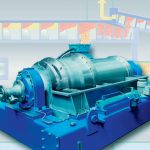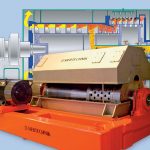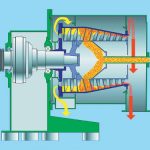Siebtechnik started as a machine and plant manufacturer based on traditional craftsmanship. This traditional company in Mulheim is nowadays an internationally recognized centrifuge technology centre. The more than 6000 centrifuges operating worldwide in various industries, namely chemical, pharmaceutical, food, environmental and recycling plants are prove of this recognition. cpp visited the liquid-solid separation specialists and interviewed Horst Dietschreit, Technical Head of the Department Centrifuges at Siebtechnik.
Siebtechnik, like all other suppliers, offered standardized centrifuges until the mid eighties. The users of these centrifuges were prepared to compromise on residual moisture, throughput and efficiency up to that time. However, the increase in competition and growing demand from the user side required a new approach. A custom made solution was required, that especially applied to a medium sized company without mass production like Siebtechnik. “This was the reason at the time for the decision to change our strategy,” explains Dietschreit. “Instead of standard centrifuges we moved towards special centrifuges to satisfy our customers needs. G-force, dwell time, solid thickness, capacity and the geometry of the drainage areas were designed for each customers specific application. This new corporate philosophy resulted in an image change in the market. Furthermore, the organizational structure in the company had to be adapted to the new realities, followed by the demand on qualification and increase in numbers of personnel to handle the new circumstances. A centrifuge manufacturer based on craftsmanship thus changed to a technological centre with 30 different laboratory and pilot plant facilities at its disposal, some of them are mobile units to travel the world together with our test engineers.”
Siebtechnik offers ten different types of centrifuges, namely Conturbex conical screen centrifuges, Conthick conical screen centrifuges with pre-thickening, pusher centrifuges, vibratory centrifuges, twin cone decanters and short bowl decanters. This range of centrifuges is rounded off by the Centriflex laboratory centrifuge. All of these centrifuges are offered in at least ten different sizes and design variations.
With the second cone
Single-stage decanter centrifuges have proven themselves in demoisturising granular solids. In these machines, the demoisturising process takes place in the conical drying zone at the end of the solid-bowl drum. “In this comparatively small and tapering drainage field”, explains Dietschreit, “only low g-forces, short dwell times and great layer thickness are attained. The unfavorable process conditions add up to high residual moisture contents in the final product. We were able to discount this drawback in the standard decanters by developing the twin cone de-canter”. This is a decanter with two cones for clarification and drying.
The suspension fed through a delivery pipe is accelerated in the clarification drum. Subsequently, the solid sedimented in the clarifying drum passes a short cone were it is pre-thickened. The filling contents of the clarifying drum and thus the length of the drying zone are infinitely variable using a sump disc. The pre-thickened solids arrive in a second, considerably larger dry cone via a discharge edge at the end of the clarification drum. Here the filter cake is again broken open and spread in a thin layer on the considerably larger inside surface of the drying cone. At the same time, the larger diameter of the drying cone ensures high g-forces at comparatively low rotor speeds. With the twin cone decanters, solids with a granular size of #80 µm can be separated. The machines come with drum diameters (second cone) of 300 to 1200 mm.
High-performance combination
The turbo screen decanters are designed for separating filtration capable solid particles larger than 80 µm. This combination of de-canter and worn/screen centrifuge is likewise designed in two stages. Unlike the twin cone decanter, there is, instead of a conical solid dry drum, a cylindrical screen drum with gap openings from 80 to a maximum of 300 µm. Dietschreit explained about the way the turbo screen decanter works: “The suspension to be processed is pre-thickened in the clarifying drum. The moist filter cake then makes its way to the screen drum, where it is again broken up and spread. The screen drum’s diameter is considerably larger than that of the clarifying drum and may be between 300 and 1200 mm. Due to this larger diameter, up to a 20 to 30 % higher g-force can be attained than on the drying zone of the clarifying drums. Moreover, the clearly larger surface offered ensures that the filter cake can be spread in very thin layers inside the screen drum. These factors and the much longer dwell time compared to a single-stage machine makes sure that a dry substance with very low residual moisture leaves the turbo screen decanter.”
For high process temperatures
Short bowl decanters are single stage solid bowl centrifuges. Unlike conventional decanters, the decanter drums in these machines, they can be 140 to 1200 mm in diameter, are pivoted on one side. “This floating mounting has several benefits,” explains Dietschreit. “There are no shaft feedthroughs in the process room, which means that the separated solids can leave the machine unhindered. All rotating parts of the machine are very easily accessible, simplifying inspection, cleaning and maintenance very much. Compared to other solid-bowl centrifuges, the short bowl decanter thus offers the best prerequisites for CIP cleaning. Moreover, this overhang design of the decanter drums allows applications with very hot products at temperatures of up to 400 °C. Such high medium temperatures can hardly be managed normally in centrifuges with bearings mounted on either side.”
Apart from the above mentioned advantages, the floating drum bearing also means, however, certain limitations: It cuts down on the operating speed and gives a low diameter/length ratio for the decanter drum. Before this backdrop, the short bowl decanters are especially suitable for separating solids with very good sedimentation behavior. This means the solids must have either a sufficiently large density difference to the liquid medium or a sufficiently large particle size, allowing for sedimentation inside the decanter drum in the comparatively short dwell time.
Concerning the function: The suspension to be processed is fed into the charging room of the scraper worm through an infeed pipe. From there the product arrives in the decanter drum through openings, where it is accelerated to the circumferential speed. Sedimentation of the solids occurs on the drum’s inside surface. The solids are transported to the ejection edge with a feed screw along the conical part of the drum.
Various executions
To ensure a high degree of maintenance friendliness and service life of the centrifuges, all gears and bearings are connected to a recirculating oil lubrication system. All three centrifuge types can be executed as open, gas or pressure resistant systems. Using the Atex package offered by Siebtechnik, the plants can be adapted to applications in explosive areas without any difficulties. This package contains all additional components necessary for this adjustment. Those parts in contact with the product are generally made of stainless steel surface roughness according to the user’s specifications. Other materials are possible, for example carbon steel or titanium, on request. What these centrifuge executions have in common is their cleaning-friendly design. For hygienic applications, they also come in a CIP and SIP-capable version. What is more, Siebtechnik is about to have the decanter centrifuges certified according to USDA standards.
Asked about future developments from Siebtechnik, Dietschreit answered: “Our engineers are assiduous working on a new generation of centrifuges. Despite the fact that these machines will have bearings on both sides of the drum, they can be used for process temperatures of up to 350 °C and pressures of up to 15 bar. Moreover, with these larger centrifuges maximum g-force of 2,000 to 2,500 will be attainable. We plan market launching for the end of 2007.” (le)
Twin cone decanter cpp 424
Turbo screen decanter cpp 425
Short bowl decanter cpp 426
From Muelheim throughout the world
Wilhelm Heinrich Steinhaus founded Steinhaus & Co. GmbH in Muelheim an der Ruhr in 1922. The enterprise specialized in selling and later also in manufacturing filter media for the neighboring coal mines. The company name was changed to Siebtechnik GmbH in 1930. In the forties, Steinhaus decided to expand his company’s product range.
The first centrifuge was designed in 1943, two years later saw the start of production of vibratory screens and vibratory centrifuges for dewatering nutty slack. Today, Siebtechnik is offering ten different centrifuge types. This traditional enterprise, which is broken down into the three divisions, screens and jigs, samplers, comminution and laboratory plants as well as centrifuges, now belongs to Stafag Holding AG. Consolidated in this holding are Hein, Lehmann GmbH, Steinhaus GmbH as well as Tema Holding N.V. and the South African Multotec Group. Dietschreit says: “International sales of our machines, for example to China, are conducted traditionally via Tema Holding. The first major orders were booked to China as early as in 1975.“ Today, Tema Holding is also responsible for manufacturing machines alongside international sales to some countries. Siebtechnik also works just as closely with Hein, Lehmann and Steinhaus. These two affiliated companies produce the filter media which are later implemented in the centrifuges. Siebtechnik employs 250 on the workforce in Germany. In 2005, the turnover was just under 38 Million Euro.
Decanters and others
Share:










